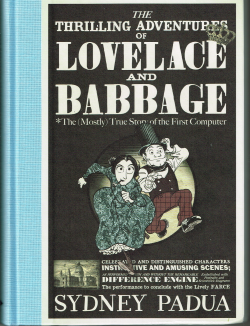 Ada Lovelace was born in 1815, so this is the 200th anniversary of her birth. When she grew upon, she was one of the few people – possibly the only person – to fully understand the possibilities of Babbage's Analytical Engine. Indeed, she is credited with writing what was, in effect, the first computer program.
Ada Lovelace was born in 1815, so this is the 200th anniversary of her birth. When she grew upon, she was one of the few people – possibly the only person – to fully understand the possibilities of Babbage's Analytical Engine. Indeed, she is credited with writing what was, in effect, the first computer program.
Unfortunately, Ada Lovelace died young, at the age of 36, and Charles Babbage never built his Analytical Engine. Had Lovelace lived, and had Babbage actually built his invention, the computer would have been invented a hundred years before it was.
Isn't that an astonishing thought?!
That's where it ended – in this universe. Using the age-old sci-fi trick of positing multiple alternate realities, Padua imagines what might have happened had things turned out differently. This is all done through the medium of a graphic novel, and plenty of humour.
Now, you might think "Who wants to read an imaginary tale? What's the point?". And you would be right, were it not for Padua's meticulous research. This enables her to build on real events, and to extrapolate from them, as the copious notes make clear.
In fact, even if you don't like graphic novels, this book is worth buying for the notes alone. There is also an in-depth illustrated exposition of how the Analytical Engine was designed to work.
I found a number of things fascinating. First, I hadn't realised until I'd read this book that Lovelace anticipated, by a decade, Boolean Logic. I also hadn't realised how close the Analytical Engine was to a modern computer in terms of the way the Analytical Engine was supposed to work. For example, it used a Store – what we would call Memory.
I've always thought of Babbage's Difference Engine as a massive calculator, which is what it was, of course. What I didn't know until I read this book was that Lovelace realised that the principles upon which it worked could be applied to any form of data – including music. She wrote that if sounds were capable of being expressed in notation that could be understood by the "Engine",
"the engine might compose elaborate and scientific pieces of music of any degree of complexity or extent."
The only slight irritation is that the footnotes and endnotes are so multitudinous that reading them interrupts the flow of the novel itself. I'm not sure that anything could be done about that though.
I always think that one indication of a good book is that it makes you want to explore the subject further. Reading this one has made me want to read Lovelace's original paper and read her biography. I'd also like to find out more about Charles Babbage. I think I'll start by reading his autobiography.
This book would make an excellent introduction to computing ideas for both teachers and pupils. Even if you can't understand all of the science involved (some of the footnotes are challenging to the layperson), the humour and the graphics will carry you through.
Rating: 4.5/5
One line review: This is a must for your classroom bookshelf.
You can buy it by clicking here:
The Thrilling Adventures of Lovelace and Babbage: The (Mostly) True Story of the First Computer
(Disclosure: that's an affiliate link.)
This article first appeared in the Digital Education ezine.
Sign up for my ezine, Digital Education, for great content, longer articles, book reviews, news, comment and guest articles.
